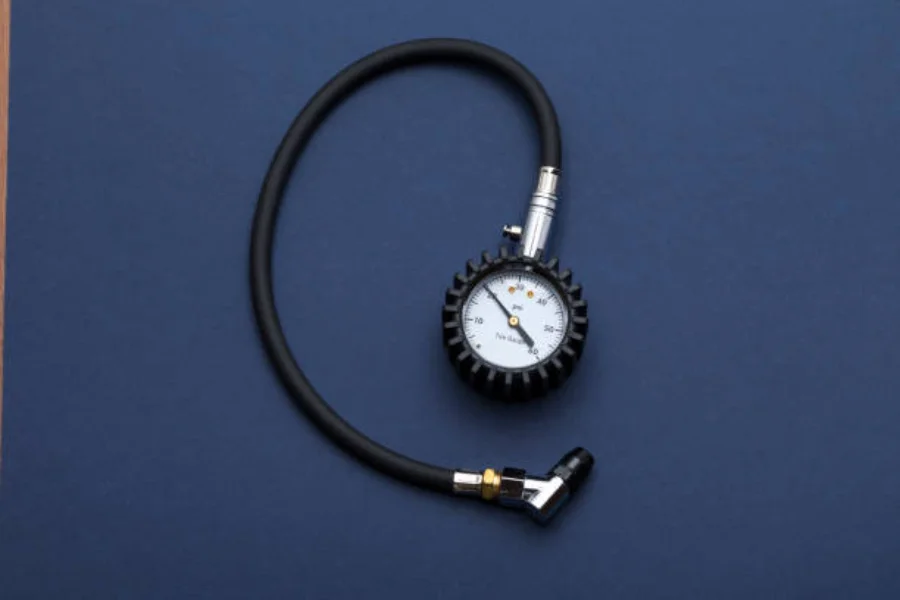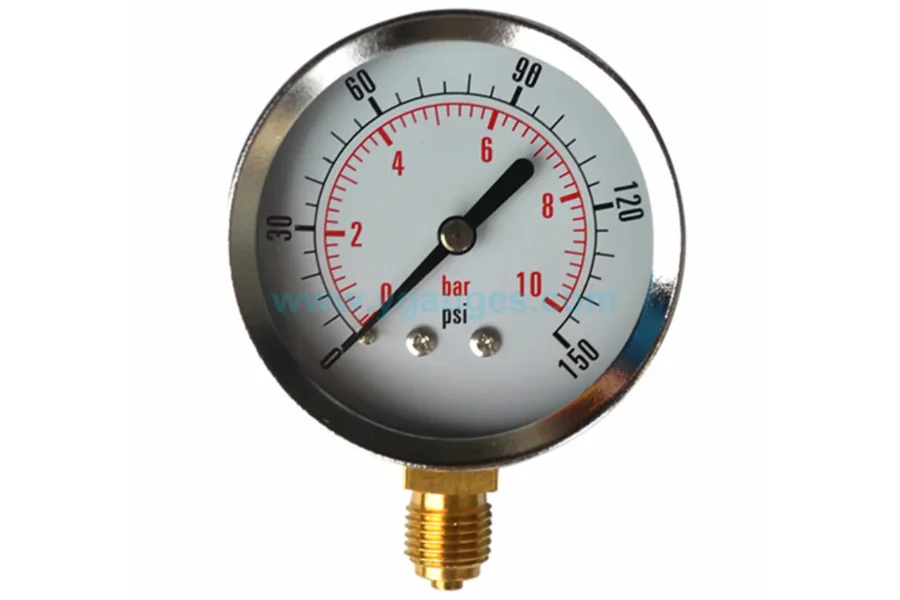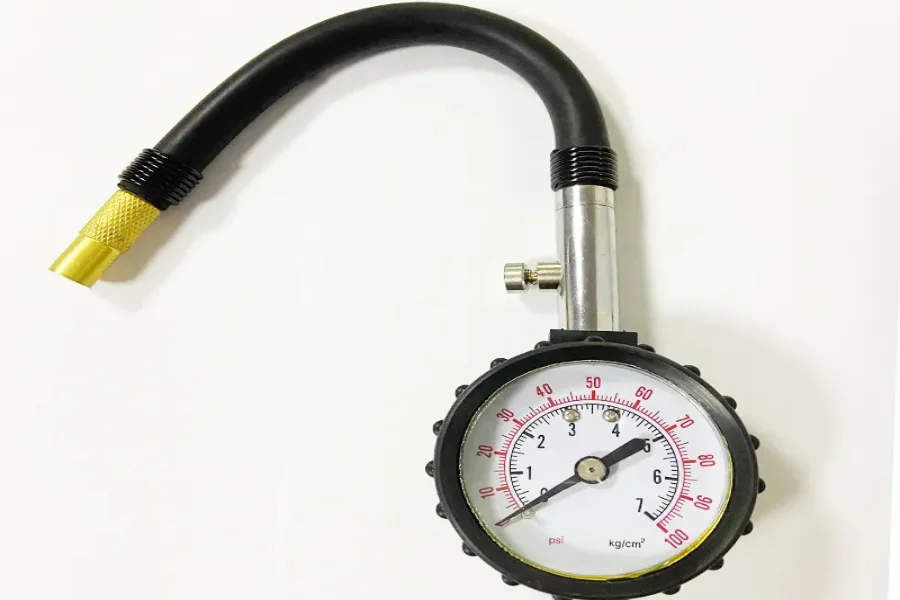Having the right tire pressure gauges in your car increases the car’s longevity and helps maintain safety. Under-inflated tires can cause decreased fuel efficiency, increased wear and tear, and impact handling. On the other hand, when car tires are overinflated, they can lead to an increased risk of blowouts and harsh rides.
In today’s market, many tire pressure gauges are available, which makes it hard to know how to source the right one. This article will highlight the market share, size, and demand for the tire pressure gauges before discussing the different types of tire pressure gauges available, and the key factors to keep in mind to ensure one chooses a suitable tire pressure gauge.
Table of Contents
Overview of the tire pressure gauges market
Types of tire pressure gauges
How to select tire pressure gauges for your car
Conclusion
Overview of the tire pressure gauges market

The global tire pressure gauges market is segmented based on types, vehicle types, distribution channels, propulsion, and regions. Automobile manufacturers are implementing the needs of their potential market to enhance safe and comfortable driving. They have invested heavily in technological advancements in relation to tire pressure management. These major players include Continental AG, Goodyear Tire & Rubber Co., and Hitachi Astemo Ltd.
According to Allied Market Research, the global tire pressure gauges market registered a value of USD 5.32 billion in 2021. A further expansion projection indicated that the value would go up to USD 12.32 billion by 2031. This represented a continuous annual growth rate of about 8.6% during the forecast period. The increase in demand for safety features in automobiles will augment the growth.
Considering types, the direct tire pressuring gauging system segment attributes for more than four-fifths, the largest market share in 2021. It is expected to dominate the market with a compound annual growth rate (CAGR) of 9.0%. The OEM segment held the largest market share with almost a 90% representation. In contrast, the aftermarket segment will grow at a CAGR of 11.8% during the forecast period. Additionally, the passenger vehicle held the largest share of about three-fifths. The commercial vehicle segment will register a CAGR of 9.3% to the end of the projected period. Regionally, Europe dominates the global market and is anticipated to record a CAGR of 9.5% towards 2031.
Types of tire pressure gauges
1. Stick pressure gauges

Stick pressure gauges are pressure-measuring devices that involve flexible or rigid sticks to determine the pressure of a gas or fluid. They are usually used in several industrial scientific and automotive applications where pressure levels are crucial. There are two types of stick pressure gauges, which are bourdon and manometer gauges.
Manometers have a partially fluid-filled U-shaped plastic or glass tube. The fluids used include mercury, oil, or water. The pressure being measured is applied on one end of the tube to cause a displacement measured by a scale. The resulting height difference between the two ends shows the pressure difference. Bourdon gauges have a flexible metal tube (bourdon tube) connected to a pointer on a dial. Pressure applied on the bourdon tube straightens it and moves the pointer, indicating the gauge’s pressure.
2. Digital pressure gauges

Digital pressure gauges measure pressure using electronic sensors while displaying the readings. They give precise and accurate pressure measurements in industrial scientific and automotive applications. The electronic sensor uses a piezoelectric crystal, strain gauge, or capacitive element to recognize pressure changes. This pressure change is converted into an electric signal by the sensor and processed by an electronic circuit to display as a digital screen reading. The digital display is in the form of a light-emitting diode (LED), liquid crystal display ( LCD), or other electronic screens. Some common digital pressure gauges include panel-mount, handheld, and portable gauges with data logging integrations and wireless connectivity characteristics.
3. Dial pressure gauges

Dial pressure gauges are tools that involve a mechanical mechanism to show fluid or gas pressure. They have a pointer in a circular dial with a bourdon tube that moves the pointer as pressure changes. The dial has a marked scale to indicate the pressure level in units of force per unit area, like bar or pounds per square inch (psi). Apart from the bourdon tube, other mechanical systems include bellows, diaphragms, and capsule elements. These gauges are widely used in industrial scientific and automotive applications. For instance, some dial gauges are used in high-vibration environments or with hazardous materials.
How to select tire pressure gauges for your car
1. Range
The range of pressures a tire gauge can measure is vital when choosing the appropriate one. Buyers should consider the type of vehicle to acquire a tire pressure gauge with the required range. On average, most light-duty trucks and passenger cars have tire pressures recommendations of about 30- 35 psi . As such, they will need a tire pressure gauge range of 0-60 psi. This will give accurate measures of tire pressures and slight adjustments for higher pressures needed for heaviest loads. In contrast, commercial or heavy-duty vehicles have higher tire pressure recommendations of up to 100 psi or more. These vehicles will require a tire pressure gauge of about 0-150 psi. The gauge should be regularly calibrated with the required accuracy against the standard tire pressure gauge.
2. Cost
Tire pressure gauge costs vary depending on its quality and type. Generally, mechanical gauges are less expensive than digital gauges. On average, basic mechanical, dial and digital gauges cost around USD 5-10, USD 10-20, and USD 15-30, respectively. Whilst the basic mechanical gauges are cheap, they may result in inaccurate readings, incorrect tire pressures and safety issues. In this case, buyers should acquire tire pressure gauges that meet their needs and budget. The gauge should give accurate and reliable measurements for proper tire inflation, reducing wear and raising fuel efficiency.
3. Durability
Durability is equally crucial when it comes to tire pressure gauges. Gauges can fail or become inaccurate over time, if they are not designed to last. Incorrect readings will result in unsafe driving conditions. The factors that determine the durability of tire pressure gauges include material used in construction and protection cover. Gauges constructed with sturdy materials like aluminum or steel have longer service lives. This is because the materials can withstand wear and tear with regular use of the gauge. Additionally, the protective case prevents damage due to drops or impacts and keeps debris and dirt from altering the gauge’s accuracy.
4. Portability
The portability factor is considered when buyers intend to check tire pressures on the go or in many vehicles that need regular pressure checks. The small and lightweight gauges, like the pencil-style or digital gauges can fit in pockets. Some gauges have protective cases or storage pouches. This helps keep the tire pressure gauge clean and protected while drivers are on the go. Additionally, the hose length determines the portability and usage of a gauge. For instance, large vehicles require longer gauges of about 10 inches.
5. Ease of use
Buyers should opt for easy to use gauges to get consistent and accurate readings when checking tire pressures. Gauges should have a clear and easy-to-read display. Large and digital displays are easier to read than smaller and analog displays. Also, gauges that come with built-in calibration features are easy to read. The needed pressure range should be within the acquired gauge. As such, gauges that measure low and high pressures are more versatile and easier to use. Considering ergonomics, buyers should purchase gauges that are easy to hold when using. Gauges with contoured shapes or non-slip grips can easily measure multiple tires.
6. Accuracy
Considering accuracy, there are set standards that tire pressure gauges should meet. Both analog and digital gauges provide certain levels of accuracy, but digital gauges are more precise. Analog gauges have misreadings or parallax errors depending on their viewed angles. Additionally, the easy-to-calibrate gauges provide more accurate readings. Buyers should consider the special tools that are sometimes needed when calibrating some tire pressure gauges. Additionally, they should follow the manufacturer’s directions concerning accuracy for safe driving and optimal fuel efficiency.
Conclusion
Most importantly, it is essential to prioritize accuracy when selecting tire pressure gauges. Buyers should consider their vehicle types to acquire the appropriate gauges that meet industry standards. This will enhance safety while driving and ensure longer service lives for tires. To acquire high-quality tire pressure gauges, visit Alibaba.com.




